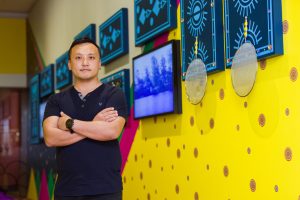Artist examines the refugee experience in Brisbane festival
A stunning and compelling new artwork explores the physical, emotional and spiritual dimensions of the refugee experience.
Created by Vanghoua Anthony Vue, ‘Chaw So’ is amongst the most provocative artworks to be exhibited as part of the Brisbane Art and Design (BAD) Festival 2023.
The visual artist and designer said:” ‘Chaw so’ means ‘resting place’ in Hmong.”
Mr Vue embraces relational art, a medium which emerged during the 1990s that incorporates social interaction.

In this instance, he invites audiences to enter a stretched blue tarp embellished with CHAWSO logos of his own design on the mezzanine of Fireworks Gallery.
The structure references “bureaucratic processing zones” in Thai refugee camps, one of which was home to his family for over a decade.
“To anyone other than refugees, such places might appear horrific”, Mr Vue said.
“But for members of the Hmong community who were fleeing from Laos in fear of their lives, they were sanctuaries.”
With the acronym of his fictional organization standing for “The Centre for Hmong Australian War Secret Operations”, Mr Vue fosters investigation into the experiences of refugees through presenting meticulously compiled documentation of both legal and illegal camps.
Whilst some facilities, such as the Nong Khai Immigration Detention Centre, continue to process asylum seekers, others operated at different periods from the mid-1970s.
Using gloves, audiences are encouraged to sit and peruse nine dossiers, which contain photographs, maps and newspaper clippings.
Mr Vue’s installation responds to themes set by the curators of Halfway House, Lily Eather and Pat Hoffie, the latter of which has been a steadfast advocate for asylum seekers in Australia over the past two decades.
This interpretation of refugee camps as “purgatory” is the most recent of three major showcases of his artworks this year.
The corners of his tarp are secured to the ground using chains of rubber bands from Thailand, products of the plantations that now operate in the location of former camps.
Their presence also reflects Mr Vue’s tendency to repurpose and elevate everyday objects.
It is for these demonstrations of the resilience and ingenuity shared by migrants that Vue is becoming known in Queensland.
 Between August 2022 and January 2023, Mr Vue contributed to the exhibition Embodied Knowledge at the Gallery of Modern Art I Queensland Art Gallery (QAGOMA) with a monumental tape installation and a series of elaborate headdresses.
Between August 2022 and January 2023, Mr Vue contributed to the exhibition Embodied Knowledge at the Gallery of Modern Art I Queensland Art Gallery (QAGOMA) with a monumental tape installation and a series of elaborate headdresses.
The headdresses portray members of his community, through their incorporation of domestic and industrial objects which have been in physical contact with the subjects.
The use of electrical tape to adorn a wall with Hmong inspired symbols references both experiences of the artist as a child in North Queensland and his people as they endured generations of displacement.
Whereas his family taped glass for physical protection during cyclones, the Hmong embroidered totemic symbols on garments to provide spiritual protection.
Communities of the Miao subgroup emigrated from China during the nineteenth century, prior to fleeing from Laos to Thailand.
Mr Vue was born in Sydney in 1989, a year after his family’s arrival in Australia.
He grew up amongst the largest Hmong community in Australia, which has grown from approximately 600 to over 1000 since the 1990s; the national population is just over 1500.
Although Mr Vue identifies as a “White Hmong”, as determined by their traditional textiles, the aesthetics of the “Black Hmong”, with an emphasis on indigo floral patterns, heavily features in his solo exhibition at Museum of Brisbane (MoB).
In contrast to the QAGOMA artworks, the large installation in ‘Ua li ua tau’ – Making do investigates places of significance as opposed to people.
Central to this elongated installation is video documentation of three rivers, including the point his family crossed from Laos into Thailand during the 1970s and the Logan River close to which Mr Vue presently resides.
Notably, Mr Vue describes the final journey of a human spirit in saying, “…the placenta is the spiritual jacket… a Hmong person must return back where it is buried at birth to wear their placenta which will allow them to cross over the other side.”
There are many childhood references in Ua li ua tau including tennis balls, which dually serve to represent his love of sport and a Hmong coming-of-age ceremony.
“We also throw tennis balls, a replacement for fabric balls, at Hmong New Year celebrations for courtship purposes… it is something that the Hmong community tries hard to maintain,” he said.
“The tennis ball is thus an object which evokes strong emotions and memories for myself.”
Visitors and residents of South-East Queensland can experience these emotive recounts of the refugee experience at Fireworks Gallery until 10 June and MoB until 30 July. Further information about these exhibitions is available at: https://www.fireworksgallery.com.au/exhibition/halfway-house-where-chaos-meets-critique and https://www.museumofbrisbane.com.au/whats-on/artist-in-residence-vanghoua-anthony-vue/.
By Pamela See
Photos by Joe Ruckli and Vanghoua Anthony Vue












